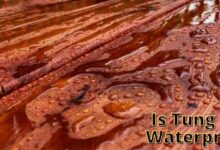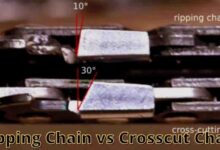You could be a beginner in woodworking. You’re probably eager to know all about gluing stained wood.
But it can be really concerning for you if you can glue stained wood or not.
So, does wood glue work on stained wood?
The answer is yes. You can glue on stained wood. In this article, we’ve mentioned the best glues you can use for stained wood. Namely, Gorilla wood glue, Titebond Polyurethane Glue, and Elmer’s wood glue MAX.
You’ll find the details of these glues in this article with their pros and cons.
Contents
What is Wood Stain?
You might be wondering what is wood stain and what is wood stain made of. Wood stains are a range of solvent or gel-based solutions that color and preserve the wood. They can come in a range of sizes and shapes.
But they always include a coloring agent that is blended or dissolved in a liquid material. Usually, water, alcohol, oil, or polyurethane can all be used as a liquid.
Protecting your wood from decaying is among the main reasons to invest in wood staining. Wood starts decaying when it is used outside without a proper sealer.
Because the wood grain absorbs the moisture that falls on the surface. You can preserve your wood from mold, fungus, and pests by staining it.
It’s also essential to know what to use for staining which slab of wood.
Now let’s dive into your main query.
Does Wood Glue Work on Stained Wood?
The answer is yes. Gluing stained wood is applicable. You can apply wood glue on stained wood. And it will work just fine.
But remember to keep in mind that the quality of the work depends on the type of glue you are using. We’ll discuss the best types of wood glue in a bit.
You could also ask, does wood glue work on sealed wood? The answer is yes. But it’s not as strong as bare wood. Naturally, woods have a lot of pores.
When the glue is applied to bare wood the glues weep into the pores. Which makes the wood joints stronger.
On the other hand when the wood is sealed with a wood stain then the pores are sealed. Then when you apply glue over it the wood joints won’t be as strong.
However, in some instances, you should apply wood stain before gluing it.
If you’re building a cupboard, for example, staining the undersides after gluing is completed is tricky.
In that scenario, the ideal way is to start with the staining and then move on to the gluing. As a result, you must understand how to use wood glue after staining the wood.
Besides you’d want to use contrast stain tints on your wood. In such cases, attaining the correct results after assembly may be difficult.
For this, staining first and assembling afterward is the best option. In this approach, the odds of receiving a color you don’t like are lowered.
Best Wood Glues For Stained Wood
Now you could be wondering what glue to use for gluing stained wood. Here we’ve mentioned some of the best glues to use on stained wood.
Type 1: Gorilla Wood Glue
Advantages Disadvantages Very strong bond over stained wood Needs clamping. Weather resistance (used both outdoors and indoors) Very high curing time. Not damage the joint’s strength Give natural color after drying
Gorilla glue is a PVA adhesive that can provide a strong bond between stained wood. It has good weather resistance and may be used both outdoors and indoors.
Shelf Life:
Once the glue container is opened, the recommended time to use is within 2 years. But this also depends on the condition the glue is stored in.
It is recommended to store the glue at room temperature. The room should not be dark. And should have at least a minimal source of light.
But let’s say you have no way to cover the glue. In that case, an open container of Gorilla glue will last for about 6 to 8 weeks.
Advantages:
Gorilla Glue will help you build a very firm and strong joint. Besides, it is weather resistant. And so it can be useful for indoor as well as outdoor use.
Apart from that, the Gorilla wood glue will also give your wood a natural finish. When it’s dry it gives natural color to the wood. Which makes the bond line invisible.
In addition, you can also sand over the joints made with Gorilla Glue. It will not damage the joint’s strength.
And finally, after using the Gorilla glue you’ll find that it does not change the dimensions.
You can also use gorilla glue for plywood.
Disadvantages:
One of the things to note about the disadvantages of this glue is that it needs clamping. Once you apply this glue, you need to clamp your joints together.
The joints need to be clamped for about 20-25 minutes to get the desired result. Other than that, Gorilla glue has a very high curing time. It takes around 24 hours for the glue to cure.
Price:
The Gorilla Glue comes in different containers and sizes. The price depends on the size and packaging.
Type 2: Titebond Polyurethane Glue
Advantages Disadvantages Very strong bond over stained wood Will not work without moisture. Waterproof & Solvent-free Expands after application.
Titebond Polyurethane Glue is one of the, if not the best glue to use over stained wood. It provides an epoxy-like ability to help build powerful joints.
Titebond has the ability to keep any stained wood joined together. More notably, Titebond glue is completely waterproof. In addition, this glue is also solvent-free.
Titebond Polyurethane Glue is perfect for metals, ceramics, HPL, Corian, stone, etc. in addition to exceptional wood-to-wood performance.
Shelf Life:
In an unsealed canister, Titebond Glue has a 1-year shelf life. However, it may be used as long as the glue is still fluid.
On the other hand, Polyurethanes react when they come into contact with moisture. After the canister has been unsealed, it may start to cure and harden.
Advantages:
Titebond glue creates a very strong bond over stained wood. These bonds cannot be broken easily. Thus, this will give your wood a more firm structure.
Besides, Titebond Polyurethane is also waterproof. Well, there are 3 kinds of Titebond glues. The first one is TItebond Original which is not waterproof and is used for indoor purposes.
The second one is Titebond 2 which is water-resistant and can be used for outdoor purposes. And lastly, the Titebond 3, is completely waterproof.
The Titebond 3 dry time depends on various factors. Another advantage of this glue is it is 100% solvent-free.
Disadvantages:
One of the drawbacks of this glue is that it requires moisture for curing. Without moisture, this glue will not cure. This means this glue will not work without moisture.
Other than hand, another major issue with this glue is it expands. After the application of this glue, it tends to expand. Which could alter the dimensions of the structure.
Price:
The price of Titebond depends on the size of the container and packaging. There are lots of sizes available to choose from.
These sizes are very convenient to use and can be stored easily.
Type 3: Elmer’s wood glue MAX
Advantages Disadvantages Weather resistant (Ideal for both interior and exterior applications) Will not work without moisture. Sandable, paintable, and weatherproof Expands after application. Very strong joints & non-toxic glue
Elmer’s wood glue MAX is a polyurethane glue. This glue is ideal for both interior and exterior applications. It’s also sandable, paintable, and weatherproof.
Elmer’s wood glue MAX may form a strong binding that is tougher than that of the surrounding wood. So, there’s no need to be worried about the joint collapsing due to a lack of strength.
Shelf Life:
Elmer’s wood glue MAX has a shelf life of about 2 years. Which means after the container is unsealed you’ll be able to use this glue for about two years.
However, if the glue gets hard or turns orangish in color then it means the glue is not effective. You should not use that glue.
You need to store this glue at room temperature. But make sure the glue has a lid on. It will get hard soon. As a result, then you won’t be able to use it.
Advantages:
One of the advantages of this glue is that it forms very strong joints. This will make your entire structure solid. Besides, it also requires less clamping time.
Another advantage of this glue is that it is non-toxic glue. Which reduces health hazards. This glue also does not produce any fumes. Which makes it even safer to use.
In Addition to that, this glue is weather resistant. Which means you can use this glue for both interior and exterior applications.
Disadvantages:
One of the major disadvantages of this glue is this glue can only be used on wood. This glue will not work well on other surfaces. Wooden surfaces are perfect for this glue.
Another disadvantage of this glue is it cures relatively quicker. So an unsealed container may be hardened faster.
Price:
The price of this glue too depends on size and packaging.
How to Apply Wood Glue on Stained Woods
Step 1: Prepare the Wood
The first thing you should do is prepare the wood. How to do it? You should ensure as little stain as possible in the area where you’ll apply glue. For that, you could directly sand the area. Or you could use stain remover.
Step 2: Apply the Glue
When applying over stained surfaces, make sure to apply glue on both surfaces. Meaning, you should apply glue to both joints for a stronger joint.
Step 3: Clamp the Pieces
Once the glue is applied you need to clamp the pieces together. You can follow this link for clamping tricks and tips.
On stained wood, clamping pressure should be applied. The pieces of wood should be clamped for about 25-30 mins. But the time depends on the type of glue.
Once the woods form the bond they should be left to cure overnight.
Step 4: Clean the Excess Glue and Store
Lastly, you must clean away the excess glue. You should clean the glue while it’s still wet after clamping.
Then after you’re down store the rest of the glue in a cool room.
FAQs
Can you glue dyed wood?
Yes, dyed wood can be glued over. You can use regular PVA glue over the dyed wood. This will not create an issue. However, if you could have already used dewaxed shellac to seal the dye. Then in that case you could face some issues.
Can wood stains be fixed?
Yes, wood stains can be fixed. To rectify a wood stain issue, sand the wood and stain it again. Though, it is time-consuming. There are alternative techniques that might provide a good finish. These are applying an extra coat of stain, painting the item, and evening the artwork with gel stain.
Can you get rid of excess stains?
Yes, you can get rid of excess stains. Scrub the wood with a wet cloth soaked using mineral spirits to remove the excess stain. This should get rid of it. Otherwise, add a second layer of stain. Wait a few moments for it to dissolve the previous, sticky stain. Then wipe off the excess with a cloth.
Conclusion
Hopefully, you got the answer to your question: does wood glue work on stained wood?
A bonus tip for you is to try not to use Super Glue for stained wood. It may work but it’s not as efficient as the mentioned glues.
See you next time. Take care.







